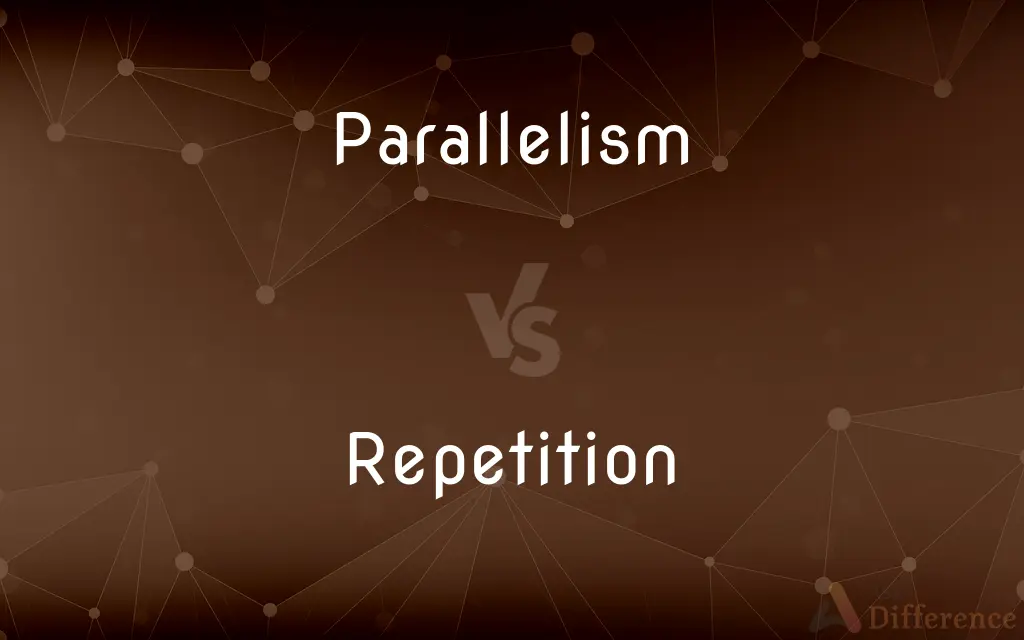Parallelism vs. Repetition — What's the Difference?
Edited by Tayyaba Rehman — By Fiza Rafique — Updated on October 12, 2023
"Parallelism" is the use of similar grammatical structures for clarity and flow, while "Repetition" is reiterating words or phrases for emphasis or effect.

Difference Between Parallelism and Repetition
Table of Contents
ADVERTISEMENT
Key Differences
Parallelism and Repetition are rhetorical devices used in English for various effects, but they serve distinct purposes. Parallelism involves using consistent grammatical or structural elements in sequences, ensuring clarity and rhythm. For instance, "Like father, like son" uses parallel structure. On the other hand, Repetition is about reiterating the same word, phrase, or idea to emphasize or accentuate its importance.
In Parallelism, the emphasis is on uniformity and balance. When writing or speaking, using parallel structures can make statements more persuasive or ideas more memorable. For instance, "She loves dancing, singing, and painting" employs a parallel structure. In contrast, Repetition seeks to drive a point home by reiterating it, as seen in Martin Luther King Jr.'s "I have a dream" speech, where the phrase "I have a dream" is repeated multiple times for emphasis.
Another distinction between Parallelism and Repetition lies in their applications. While both can be used in prose and poetry, Parallelism often finds its place in arguments, lists, or series to maintain a consistent flow. For example, "To err is human; to forgive, divine." showcases parallelism. Repetition, however, is frequently employed in poetry, speeches, and songs, where the repeated element creates a rhythm or emphasizes a theme.
In summary, while both Parallelism and Repetition can enhance the quality of written or spoken English, they do so in different ways. Parallelism provides structure and clarity by ensuring uniformity, while Repetition underlines and emphasizes through iteration.
Comparison Chart
Definition
Use of similar grammatical structures for clarity and rhythm.
Reiteration of words or phrases for emphasis.
ADVERTISEMENT
Purpose
To ensure clarity and create flow in sentences.
To emphasize or accentuate a point or theme.
Application
Common in arguments, lists, or series.
Frequently found in poetry, speeches, and songs.
Example
"Flying is fast, comfortable, and safe."
"Never, never, never give up."
Effect
Creates rhythm and uniformity in sentences.
Enhances emphasis, creates rhythm, reinforces theme.
Compare with Definitions
Parallelism
Equivalence of multiple items in a sequence.
We can either stand firmly together or surely fall apart.
Repetition
A rhetorical device to emphasize a particular point.
Let it snow, let it snow, let it snow.
Parallelism
Use of consistent grammatical structures in sequences.
She likes reading, writing, and drawing.
Repetition
Use of recurrent elements for rhythm or theme.
Oh Captain! My Captain!
Parallelism
Structuring related words, phrases, or clauses similarly.
With malice toward none, with charity for all.
Repetition
Reoccurrence of certain words for poetic or dramatic effect.
Tomorrow, and tomorrow, and tomorrow.
Parallelism
The quality or condition of being parallel.
Repetition
The act or process or an instance of repeating or being repeated.
Parallelism
Correspondence or similarity.
Repetition
A recitation or recital, especially of prepared or memorized material.
Parallelism
(Grammar) The use of identical or equivalent syntactic constructions in corresponding clauses or phrases.
Repetition
The act or an instance of repeating or being repeated.
Parallelism
(Philosophy) The doctrine that to every mental change there corresponds a concomitant but causally unconnected physical alteration.
Repetition
(weightlifting): The act of performing a single, controlled exercise motion. A group of repetitions is a set.
Parallelism
The state or condition of being parallel; agreement in direction, tendency, or character.
Repetition
To petition again.
Parallelism
The state of being in agreement or similarity; resemblance, correspondence, analogy.
Repetition
The act of repeating; a doing or saying again; iteration.
I need not be barren of accusations; he hath faults, with surplus to tire in repetition.
Parallelism
A parallel position; the relation of parallels.
Repetition
Recital from memory; rehearsal.
Parallelism
The juxtaposition of two or more identical or equivalent syntactic constructions, especially those expressing the same sentiment with slight modifications, introduced for rhetorical effect.
Repetition
The act of repeating, singing, or playing, the same piece or part a second time; reiteration of a note.
Parallelism
(philosophy) The doctrine that matter and mind do not causally interact but that physiological events in the brain or body nonetheless occur simultaneously with matching events in the mind.
Repetition
Reiteration, or repeating the same word, or the same sense in different words, for the purpose of making a deeper impression on the audience.
Parallelism
(legal) In antitrust law, the practice of competitors of raising prices by roughly the same amount at roughly the same time, without engaging in a formal agreement to do so.
Repetition
The measurement of an angle by successive observations with a repeating instrument.
Parallelism
(biology) Similarity of features between two species resulting from their having taken similar evolutionary paths following their initial divergence from a common ancestor.
Repetition
An event that repeats;
The events today were a repeat of yesterday's
Parallelism
(computing) The use of parallel methods in hardware or software, so that several tasks can be performed at the same time.
Repetition
The act of doing or performing again
Parallelism
The quality or state of being parallel.
Repetition
The repeated use of the same word or word pattern as a rhetorical device
Parallelism
Resemblance; correspondence; similarity.
A close parallelism of thought and incident.
Repetition
Reiterating the same word or phrase in a sentence or piece.
Because I do not hope to turn again, Because I do not hope...
Parallelism
Similarity of construction or meaning of clauses placed side by side, especially clauses expressing the same sentiment with slight modifications, as is common in Hebrew poetry; e. g.: -At her feet he bowed, he fell:Where he bowed, there he fell down dead. Judg. v. 27.
Repetition
Reinforcement of an idea by stating it multiple times.
And miles to go before I sleep, And miles to go before I sleep.
Parallelism
Similarity by virtue of correspondence
Parallelism
A rhetorical device that creates rhythm and clarity.
That's not only just what I should do; it's also what I must do.
Parallelism
Consistency in successive verbal constructions.
He came, he saw, he conquered.
Common Curiosities
Can Parallelism and Repetition be used together?
Yes, they can be combined for rhetorical effect.
Why use Repetition in poetry?
It can create rhythm, emphasize themes, and evoke emotions.
Are Parallelism and Repetition the same?
No, Parallelism focuses on similar structures, while Repetition emphasizes reiteration.
Does Parallelism make sentences clearer?
Yes, it can make complex ideas clearer by using a consistent structure.
Can Parallelism be found in poetry?
Yes, poets use parallel structures for rhythm and emphasis.
Is Parallelism always about grammar?
Mostly, as it concerns using similar grammatical structures for clarity.
Is Repetition redundant?
Not always. It can be purposeful for emphasis or style.
Can Parallelism be seen in proverbs?
Yes, proverbs often use parallel structures for memorability.
Does Repetition always mean exact repetition?
No, it can be slight variations of words or ideas for effect.
Is Repetition always intentional?
In literature and speeches, it's often intentional. In casual conversation, not always.
Is Parallelism common in speeches?
Yes, it helps deliver points clearly and persuasively.
Can Repetition become monotonous?
If overused or used without purpose, it can be.
What's a famous example of Parallelism?
"I have a dream" speech by Martin Luther King Jr. uses both parallelism and repetition.
Why might Repetition be used in a speech?
To emphasize a point and make it more memorable.
Does Parallelism affect sentence length?
Not necessarily. It's about structure, not length.
Share Your Discovery

Previous Comparison
BOD vs. COD
Next Comparison
Memoir vs. BiographyAuthor Spotlight
Written by
Fiza RafiqueFiza Rafique is a skilled content writer at AskDifference.com, where she meticulously refines and enhances written pieces. Drawing from her vast editorial expertise, Fiza ensures clarity, accuracy, and precision in every article. Passionate about language, she continually seeks to elevate the quality of content for readers worldwide.
Edited by
Tayyaba RehmanTayyaba Rehman is a distinguished writer, currently serving as a primary contributor to askdifference.com. As a researcher in semantics and etymology, Tayyaba's passion for the complexity of languages and their distinctions has found a perfect home on the platform. Tayyaba delves into the intricacies of language, distinguishing between commonly confused words and phrases, thereby providing clarity for readers worldwide.















































